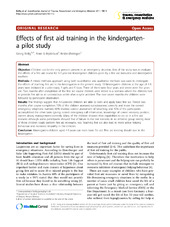| dc.contributor.author | Bollig, Georg | en_US |
| dc.contributor.author | Myklebust, Anne G. | en_US |
| dc.contributor.author | Østringen, Kristin | en_US |
| dc.date.accessioned | 2012-02-06T10:44:27Z | |
| dc.date.available | 2012-02-06T10:44:27Z | |
| dc.date.issued | 2011-02-28 | eng |
| dc.Published | Scandinavian Journal of Trauma, Resuscitation and Emergency Medicine 2011, 19:13 | en |
| dc.identifier.issn | 1757-7241 | |
| dc.identifier.uri | https://hdl.handle.net/1956/5550 | |
| dc.description.abstract | Objective: Children can be the only persons present in an emergency situation. Aim of the study was to evaluate the effects of a first aid course for 4-5-year-old kindergarten children given by a first aid instructor and kindergarten teachers. Methods: A mixed methods approach using both quantitative and qualitative methods was used to investigate the effects of teaching first aid in the kindergarten in the present study. 10 kindergarten children at the age of 4-5 years were included in a pilot-study, 5 girls and 5 boys. Three of them were four years and seven were five years old. Two months after completion of the first aid course children were tested in a scenario where the children had to provide first aid to an unconscious victim after a cycle accident. The next seven months the children were followed by participant observation. Results: The findings suggest that 4-5-year-old children are able to learn and apply basic first aid. Tested two months after course completion 70% of the children assessed consciousness correctly and knew the correct emergency telephone number; 60% showed correct assessment of breathing and 40% of the participants accomplished the other tasks (giving correct emergency call information, knowledge of correct recovery position, correct airway management) correctly. Many of the children showed their capabilities to do so in a first aid scenario although some participants showed fear of failure in the test scenario. In an informal group testing most of these children could perform first aid measures, too. Teaching first aid also lead to more active helping behaviour and increased empathy in the children. Conclusion: Kindergarten children aged 4-5 years can learn basic fist aid. First aid training should start in the kindergarten. | en_US |
| dc.language.iso | eng | eng |
| dc.publisher | BioMed Central | eng |
| dc.rights | Attribution CC BY | eng |
| dc.rights.uri | http://creativecommons.org/licenses/by/2.0/ | eng |
| dc.title | Effects of first aid training in the kindergarten. A pilot study | en_US |
| dc.type | Peer reviewed | |
| dc.type | Journal article | |
| dc.description.version | publishedVersion | en_US |
| dc.rights.holder | Copyright 2011 Bollig et al; licensee BioMed Central Ltd. | |
| dc.identifier.doi | https://doi.org/10.1186/1757-7241-19-13 | |
| dc.identifier.cristin | 830154 | |
| dc.subject.nsi | VDP::Medical disciplines: 700::Health sciences: 800::Community medicine, Social medicine: 801 | eng |
| dc.subject.nsi | VDP::Medical disciplines: 700::Health sciences: 800::Health service and health administration research: 806 | eng |

